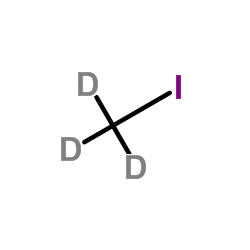Iodomethane-d3

Iodomethane-d3 structure
|
Common Name | Iodomethane-d3 | ||
|---|---|---|---|---|
| CAS Number | 865-50-9 | Molecular Weight | 144.958 | |
| Density | 2.2±0.1 g/cm3 | Boiling Point | 40.3±3.0 °C at 760 mmHg | |
| Molecular Formula | CD3I | Melting Point | -66.5ºC(lit.) | |
| MSDS | USA | Flash Point | 7.8±10.7 °C | |
| Symbol |


GHS06, GHS08 |
Signal Word | Danger | |
|
Mitigating 1,3-dichloropropene, chloropicrin, and methyl iodide emissions from fumigated soil with reactive film.
Environ. Sci. Technol. 46(11) , 6143-9, (2012) Implicated as a stratospheric ozone-depleting compound, methyl bromide (MeBr) is being phased out despite being considered to be the most effective soil fumigant. Its alternatives, i.e., 1,3-dichloropropene (1,3-D, which includes cis and trans isomers), chlor... |
|
|
Effects of depletion of glutathione on abscisic acid- and methyl jasmonate-induced stomatal closure in Arabidopsis thaliana.
Biosci. Biotechnol. Biochem. 76(11) , 2032-7, (2012) Glutathione (GSH) is involved in abscisic acid (ABA)- and methyl jasmonate (MeJA)-induced stomatal closure in Arabidopsis thaliana. In this study, we examined the effects of GSH-decreasing chemicals, p-nitrobenzyl chloride (PNBC), iodomethane (IDM), and ethac... |
|
|
A-band methyl halide dissociation via electronic curve crossing as studied by electron energy loss spectroscopy.
J. Chem. Phys. 133(5) , 054304, (2010) Excitation of the A-band low-lying electronic states in the methyl halides, CH(3)I, CH(3)Br, CH(3)Cl, and CH(3)F, has been investigated for the (n-->sigma*) transitions, using electron energy loss spectroscopy (EELS) in the range of 3.5-7.5 eV. For the methyl... |
|
|
Dissociation mechanisms of excited CH3X (X = Cl, Br, and I) formed via high-energy electron transfer using alkali metal targets.
J. Chem. Phys. 137(18) , 184308, (2012) High-energy electron transfer dissociation (HE-ETD) on collisions with alkali metal targets (Cs, K, and Na) was investigated for CH(3)X(+) (X = Cl, Br, and I) ions by a charge inversion mass spectrometry. Relative peak intensities of the negative ions formed ... |
|
|
Effects of fumigants on microbial diversity and persistence of E. coli O15:H7 in contrasting soil microcosms.
Sci. Total Environ. 409(19) , 3740-8, (2011) Persistence of E. coli O157 in the environment is a serious public health concern. However, little is known about the persistence of this pathogen after exposure to chemical compounds like fumigants in the environment. In this study, the persistence behavior ... |
|
|
Moving away from methyl bromide: political economy of pesticide transition for California strawberries since 2004.
J. Environ. Manage. 106 , 93-101, (2012) We examine the progress of the phaseout of the use of the pesticide methyl bromide in the production of California field strawberries. This phaseout is required under the Montreal Protocol and has been contentious in this sector, which receives exemptions fro... |
|
|
Fully automated and reproducible radiosynthesis of high specific activity [¹¹C]raclopride and [¹¹C]Pittsburgh compound-B using the combination of two commercial synthesizers.
Nucl. Med. Commun. 32(11) , 1011-7, (2011) The use of ¹¹C-labeled radiotracers in routine positron emission tomography studies is dependent on the production capability of radiochemistry laboratories. Therefore, considerable efforts are being focused on the development of fast, efficient, and robust m... |
|
|
Iodine bonding stabilizes iodomethane in MIDAS pesticide. Theoretical study of intermolecular interactions between iodomethane and chloropicrin.
J. Agric. Food Chem. 60(7) , 1776-87, (2012) The results are reported of a theoretical study of iodomethane (H(3)C-I, 1) and chloropicrin (Cl(3)C-NO(2), 2), of the heterodimers 3-6 formed by aggregation of 1 and 2, and of their addition products 7 and 8 and their possible fragmentation reactions to 9-18... |
|
|
Analytical challenges in the quantitative determination of 2H/1H ratios of methyl iodide.
Rapid Commun. Mass Spectrom. 27(3) , 430-6, (2013) A published method to determine the hydrogen isotope ((2)H/(1)H) ratios of methoxyl groups, cleaved from lignin by hydroiodic acid (HI), calls for the analysis of methyl iodide (CH(3)I). However, analysis of halogenated compounds by gas chromatography/pyrolys... |
|
|
Predicting methyl iodide emission, soil concentration, and pest control in a two-dimensional chamber system.
J. Environ. Qual. 40(1) , 109-17, (2011) Due to ever-increasing state and federal regulations, the future use of fumigants is predicted on reducing negative environmental impacts while offering sufficient pestcontrol efficacy. To foster the development of a best management practice, an integrated to... |